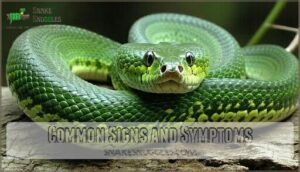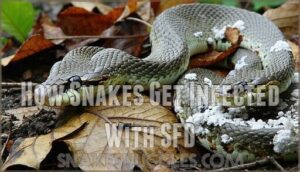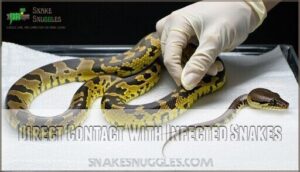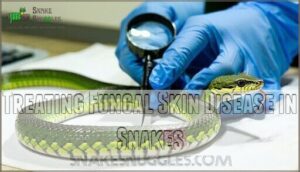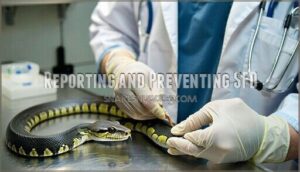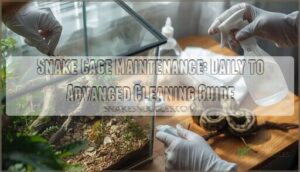This site is supported by our readers. We may earn a commission, at no cost to you, if you purchase through links.

Look for crusty skin lesions, swelling, trouble shedding, or odd behavior like lethargy.
These signs mean it’s time for a vet visit, since fungal infections can get serious fast.
Keep your snake’s habitat clean and dry, as damp conditions are a breeding ground for fungi. Don’t try home remedies; antifungal treatments from an experienced reptile vet work best.
Acting quickly gives your snake the best shot at recovery. Curious about prevention, treatment, or what causes these outbreaks? Stick around.
Table Of Contents
- Key Takeaways
- Identifying Snake Fungal Disease
- Causes and Transmission of SFD
- Treating Fungal Skin Disease in Snakes
- Impact of SFD on Snake Populations
- Reporting and Preventing SFD
- Frequently Asked Questions (FAQs)
- How to treat snake fungal disease?
- How do you treat a fungal infection on a snake plant?
- How do you treat skin fungal disease?
- What does snake fungal disease look like?
- How do you treat snake fungal disease?
- What is antifungal treatment for snakes?
- What is fungal dermatitis in snakes?
- How do I know if my snake has SFD?
- What should I do if my snake has SFD?
- Can SFD be cured?
- Conclusion
Key Takeaways
- Watch for warning signs like crusty skin lesions, swelling, trouble shedding, and lethargy—these mean your snake needs a vet fast.
- Keep your snake’s habitat clean and dry since damp, dirty environments help fungal infections spread.
- Don’t try home remedies; only a reptile vet can prescribe effective antifungal treatments for your snake.
- Isolate any sick snake right away and follow strict hygiene to prevent the disease from spreading to other pets.
Identifying Snake Fungal Disease
You’re likely worried about your snake’s health if you suspect it has a fungal skin disease.
To identify the issue, you’ll need to look for common signs and symptoms, such as skin lesions, discoloration, and behavioral changes, which can indicate the presence of snake fungal disease.
Common Signs and Symptoms
Identifying snake fungal infection involves looking out for signs like:
- Facial Swelling
- Skin Nodules
- Lethargy Signs, including Eye Cloudiness, which can indicate a snake skin disease, or fungal infection in snakes, causing skin lesions and shedding issues.
Systemic infections can also cause internal nodules to form, which is a critical aspect of diagnosing fungal infection in snakes.
Skin Lesions and Discoloration
When examining your snake’s skin, look out for lesion morphology and discoloration types, such as inflamed or crusted skin lesions, and scale abnormalities.
Skin discoloration, including redness, can indicate a snake fungal infection.
Check for ulceration severity and consider diagnostic imaging to assess the snake skin disease, focusing on skin lesions and discoloration on the snake’s skin.
Behavioral Changes in Infected Snakes
You notice your snake’s behavior changing, it may be a sign of snake fungal disease (SFD).
Look out for:
- Hiding behavior increases
- Changes in feeding habits
- Aggression levels rise
- Activity changes, such as lethargy.
These behavioral changes, paired with skin lesions, can indicate SFD, affecting your snake’s overall health, including feeding issues, social interaction, and snake skin problems.
Causes and Transmission of SFD
You’re likely wondering how your snake got infected with SFD, and to fully comprehend the situation, the fungus can be transmitted through environmental contact and direct contact with infected snakes.
By knowing the causes and transmission methods of SFD, you can take steps to prevent the spread of the disease and protect your pet.
How Snakes Get Infected With SFD
You’re wondering how your snake got infected with SFD.
It’s likely due to direct contact with contaminated surfaces or infected snakes.
| Cause | Description | Example |
|---|---|---|
| Direct Contact | Touching infected snakes | Infected snake’s skin |
| Environmental Contamination | Contaminated soil, water | Fungal shedding |
| Maternal Transmission | From mother to offspring | During birth |
The causes of infection can be summarized into these main categories, which help in understanding how snakes get infected.
Role of Environment in SFD Transmission
How does your snake’s environment contribute to SFD transmission?
- Fungal survival in soil
- Humidity effects on growth
- Temperature influence on persistence
- Habitat management to prevent contamination.
Poor ventilation and high humidity create an ideal environment for fungal growth, while contaminated soil and humidity facilitate environmental transmission, highlighting the importance of environmental hygiene and habitat management to control fungal persistence.
Direct Contact With Infected Snakes
You’re at risk of SFD exposure through direct contact with infected snakes.
Practice good hygiene, wear gloves, and follow quarantine procedures to minimize risks, especially during social snake interactions and breeding season.
To prevent disease transmission and protect your snake’s health from fungal infection.
Treating Fungal Skin Disease in Snakes
You’re taking the first step in treating your snake’s fungal skin disease by learning about the available options.
You’ll need to work with a veterinarian to determine the best course of treatment, which may include antifungal medications, topical treatments, or a combination of both.
Antifungal Treatment Options for Snakes
Now that you know how snakes get SFD, let’s explore antifungal treatment options. Systemic antifungal medications, like itraconazole, are often used. Remember, treatment efficacy varies. Itraconazole Use is common, but Voriconazole Dosage and Terbinafine Nebulization might be options.
Environmental transmission is a key factor in the spread of this disease.
- Imagine tiny medicine clouds.
- Think of building a fortress of health.
- Picture your snake getting stronger.
- Visualize the fungus fading away.
- See your snake basking happily.
Supportive Therapies aid recovery, so consult a vet to ensure the best recovery and treatment efficacy for your snake.
Topical Treatments for SFD
After exploring antifungal treatment options, let’s look at topical treatments for snake fungal disease (SFD).
Applying creams or ointments right to lesions is often recommended. Specific antifungals, like miconazole or terbinafine, can make a big difference.
You can find snake fungal cream online if your vet recommends it. Stick with your vet’s plan—application methods, treatment duration, and possible side effects matter.
Effectiveness comparison varies, but these can really help recovery.
Systemic Antifungal Medications
When topical treatments fall short, systemic antifungal medications like itraconazole and voriconazole can tackle deeper infections.
These antifungal treatments for snake fungal disease require careful dosing and monitoring for side effects. Treatment duration varies, and drug resistance poses challenges.
The disease is caused by fungus Ophidiomyces ophiodiicola, an emergent pathogen in North America.
A reptile veterinarian will determine the best systemic medications for treating snake fungus effectively.
Impact of SFD on Snake Populations
When your snake has SFD, you’re dealing with a disease that’s wreaking havoc on wild snake populations across North America.
Snake fungal disease is a silent crisis threatening snakes everywhere, making every case a call to action for their survival.
Understanding how this fungal infection spreads through entire ecosystems helps you grasp why proper treatment and prevention in captive snakes matters for conservation efforts.
Mortality Rates and Population Declines
Snake fungal disease mortality-rates paint a grim picture for affected snake populations.
This devastating pathogen creates cascading effects across ecosystems:
- Extreme mortality rates – Some snake populations face up to 90% death rates, with experimental data showing 40% mortality in infected snakes.
- Severe population declines – New Hampshire’s timber rattlesnakes dropped 50% due to SFD, while endangered Illinois massasauga rattlesnakes experienced critical mortality.
- Species susceptibility variations – Regional variations show different impacts, with eastern U.S. populations hit hardest compared to milder Minnesota infections.
- Long-term ecosystem impacts – Two-thirds of monitored global snake populations collapsed since 1995, threatening genetic diversity and ecosystem balance.
Seasonal Variations in SFD Severity
Temperature effects create a rollercoaster of challenges for snakes battling fungal disease.
Spring hibernation impact hits hardest when weakened snakes emerge into variable conditions. Environmental factors like humidity influence and temperature fluctuations stress already compromised immune systems during critical molting cycle periods.
The disease, caused by Ophidiomyces ophiodiicola fungus, poses a significant threat.
| Season | Disease Risk | Key Stressors |
|---|---|---|
| Winter | Moderate | Hibernation, limited immunity |
| Spring | Highest | Emergence stress, molting cycle |
| Summer | Variable | Breeding season demands |
| Fall | Increasing | Pre-hibernation preparation |
Snake fungal disease SFD severity peaks during seasonal variations when snakes face multiple stressors simultaneously. Breeding season compounds these challenges, making disease management essential year-round.
Conservation Efforts to Protect Snakes
As SFD cases spike with the seasons, conservation efforts pull out all the stops.
Habitat Restoration helps snakes bounce back, while Captive Breeding keeps Genetic Diversity strong.
Public Awareness campaigns tackle old myths and boost support for wildlife conservation.
Policy Changes and ongoing research improve disease management and snake health.
Every step, big or small, makes a difference in fighting snake fungal disease.
Reporting and Preventing SFD
If you spot signs of SFD in your snake, it’s important to report your observation.
This action will help prevent the disease from spreading, and by acting quickly and using proper hygiene, you’ll help protect not just your pet, but other snakes in your community too, which is crucial for preventing the spread of SFD.
How to Report Snake Observations
In regards to reporting snake observations, you’re not just helping scientists—you’re joining the front lines of conservation.
Here’s your go-to checklist for making your report count:
- Follow Observation Protocols: Record the location, date, and time for Location Specificity.
- Document with Photographic Evidence: Snap clear photos showing symptoms or unusual behavior.
- Submit Data Collection online: Use platforms like HerpMapper or your local wildlife authorities’ forms for online reporting.
- Contact Expert Consultation: If in doubt, reach out to local authorities for guidance on reporting sick snakes.
Supporting local snake populations by creating snake shelters can also aid in their overall health.
Your careful reports make a real difference!
Capturing and Handling Snakes With SFD
After logging your snake observations, it’s time for safe capture.
Slip on gloves and use a snake bag or ventilated box—think of it as first-class travel for your reptile.
Consider using specialized handling equipment for added safety.
Gentle handling protocols help with minimizing stress, so move slowly and calmly.
Once secured, set up a quarantine area and follow strict biosecurity measures to prevent SFD from spreading to other pets.
Preventing The Spread of SFD in Snakes
A clean terrarium is your snake’s best friend.
A spotless home keeps your snake healthy and helps stop disease in its tracks.
To prevent the spread of SFD, lean on these preventive measures:
- Practice strict snake quarantine protocols for new arrivals.
- Use disinfection methods on all outdoor equipment.
- Prioritize habitat management and cleanliness.
- Promote public awareness about SFD risks.
- Support research into genetic resistance in snakes.
Consider using specialized cleaning products for effective disinfection.
Stay vigilant—your scaly pals depend on it, and remember that prevention is key.
Frequently Asked Questions (FAQs)
How to treat snake fungal disease?
You’ll want to isolate your snake, then call a reptile vet for antifungal treatment—topical or oral meds like itraconazole help.
Keep the habitat clean and dry.
Supportive care, good nutrition, and patience are key.
How do you treat a fungal infection on a snake plant?
Picture your snake plant as a fortress under siege—wipe affected leaves with diluted hydrogen peroxide, trim off mushy spots, and let the soil dry out.
Boost airflow, avoid overwatering, and quarantine if you spot spreading.
How do you treat skin fungal disease?
You’ll need immediate veterinary care for your snake’s fungal infection. Treatment typically involves antifungal medications like itraconazole or voriconazole, along with supportive care including proper wound management and environmental adjustments.
What does snake fungal disease look like?
Think of a snake wearing a patchwork quilt—except those patches are scabs, swollen lumps, crusty sores, and thickened scales.
You’ll also spot blisters, cloudy eyes, and odd shedding, often paired with sluggishness or loss of appetite.
The symptoms described are indicative of a snake in poor health, with sluggishness being a key sign of distress.
How do you treat snake fungal disease?
Treat snake fungal disease with antifungal medications like itraconazole, plus supportive care—think wound cleaning, fluids, and good nutrition.
Isolate the snake, keep its habitat clean, and always work closely with a reptile-savvy veterinarian.
What is antifungal treatment for snakes?
Antifungal treatment for snakes usually means giving medications like itraconazole, voriconazole, or terbinafine, sometimes as a mist.
You’ll also want to keep wounds clean, provide extra fluids, and call a reptile vet for guidance.
What is fungal dermatitis in snakes?
Fungal dermatitis in snakes means a skin infection caused by fungi, leading to blisters, scabs, or crusty patches.
You’ll notice your snake’s skin looking rough or swollen, making them itchier than a snake in a sweater, which can be a clear sign of fungal dermatitis.
How do I know if my snake has SFD?
Watch for facial swelling, crusty sores, blisters, or thickened scales, especially on the head and neck.
If your snake acts sluggish, skips meals, or sheds poorly, SFD could be the culprit—time to call your vet.
What should I do if my snake has SFD?
If your snake’s showing signs of SFD, call a reptile vet right away.
Keep it isolated, and clean its habitat thoroughly.
Follow the vet’s advice on medication and care—think of it as a spa day, but with medicine.
Can SFD be cured?
Think of SFD as a stubborn weed in the garden—it’s tough to get rid of completely.
While treatments can help, there’s no guaranteed cure.
You’ll need a vet’s help, patience, and ongoing care.
Conclusion
Picture your snake basking under its heat lamp, scales smooth and healthy—this is the goal when you address concerns like, “my snake has a fungal skin disease.”
Spotting symptoms early, seeking veterinary care, and keeping the habitat clean can make all the difference.
Don’t ignore warning signs or try risky home fixes. With quick action and proper prevention, you’ll help your snake avoid setbacks and enjoy a longer, healthier life slithering through its enclosure.
- https://www.sciencedirect.com/topics/immunology-and-microbiology/onygenales
- https://www.researchgate.net/publication/304068327_Evaluation_of_Common_Disinfectants_Effective_against_Ophidiomyces_ophiodiicola_the_Causative_Agent_of_Snake_Fungal_Disease
- http://vetmed.illinois.edu/wel/ophidiomyces-project/
- https://www.usgs.gov/centers/nwhc/science/snake-fungal-disease
- https://www.fws.gov/species/eastern-massasauga-sistrurus-catenatus

